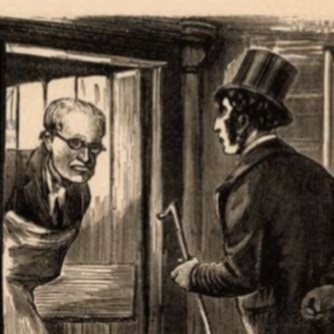
1832 - 1879
Charles Peace
Summary
Name:
Years Active:
1854 - 1878Birth:
May 14, 1832Status:
ExecutedClass:
MurdererVictims:
2Method:
ShootingDeath:
February 25, 1879Nationality:
United Kingdom
1832 - 1879
Charles Peace
Summary: Murderer
Name:
Charles PeaceStatus:
ExecutedVictims:
2Method:
ShootingNationality:
United KingdomBirth:
May 14, 1832Death:
February 25, 1879Years Active:
1854 - 1878bio
Charles Frederick Peace was born on May 14, 1832, in Darnall, Sheffield. He was the youngest son of John Peace, a shoemaker, and Jane, who was the daughter of a naval surgeon. Charles went to several schools in the area, including Pitsmoor, Dinnington, and Paradise Square. When he was just 14 years old, he suffered a serious injury in an accident at a steel-rolling mill, which left him permanently crippled.
At the age of 22, in 1854, Peace was found guilty of multiple burglaries. He was sentenced to four years of penal servitude. After serving his time, he married a widow named Hannah Ward in 1859. Shortly after his marriage, he committed a major burglary in Manchester. During the incident, he nearly killed a police officer who came to arrest him, resulting in a six-year sentence for penal servitude.
After serving this second sentence, Peace tried to run a picture-framing business. He then found work with the North Eastern Railway but was later fired for not showing up to work regularly. Peace eventually moved back to Darnall, Sheffield, where he met a civil engineer named Dyson.
murder story
On 1 August 1876, Charles Peace was seen by two policemen entering the grounds of a house in Whalley Range, Manchester. When one officer, PC Nicholas Cock, approached him, Peace drew a revolver and warned Cock to step back. When Cock advanced, Peace fired the gun intentionally wide. Cock then drew his truncheon, and Peace fired again, seriously wounding Cock, who died the next day. Peace escaped into the night. Following the incident, two local brothers, John and William Habron, were arrested for the murder of Constable Cock. John was acquitted, while William was sentenced to death; his sentence was later changed to life in prison. Peace attended the trial, ensuring he was not suspected before he returned to Darnall.
Around this time, Peace developed a strong obsession with the wife of a man named Dyson. In June 1876, Dyson sent a card to Peace asking him not to interfere with his family. On 1 July, Peace threatened Mrs. Dyson. Dyson filed a summons against Peace and moved away to another suburb. However, on the first day in their new home, Peace confronted Mrs. Dyson once again, vowing to disturb her. That evening, while Mrs. Dyson was outside, Peace approached her with a revolver, demanding she speak. Mrs. Dyson retreated inside, and when her husband appeared, Peace shot him twice, with the fatal shot hitting Dyson in the head. Peace escaped by train to Hull.
After the murder, a manhunt began with a £100 reward for Peace's capture. The police initially provided an incorrect description, which was later revised. Peace concealed his identity by using a prosthetic arm and altered his appearance as he traveled around the country. In Nottingham, he met a woman named Sue Thompson, who eventually betrayed him to the police. In early 1877, he relocated to London, believing he would be safer there, and even invited his wife and son to join him.
His criminal activities continued, including numerous burglaries, particularly in the affluent Blackheath area. Peace was caught on 10 October 1878 after a constable noticed a light in a suspicious house. When the police approached, Peace attempted to flee, shooting four times at Constable Robinson and wounding him. Peace was then arrested and charged with burglary and attempted murder.
While in custody, Peace refused to give his real name. However, he wrote a letter to an associate that led to his identification as Charles Peace. He was tried at the Old Bailey and sentenced to life in prison. After some time, he was transferred to Sheffield to face murder charges for Dyson's death. During this process, he attempted to escape but was caught again.

In his second examination, Peace’s lawyer argued that Mrs. Dyson had been more involved with Peace than she admitted. Evidence was presented, including notes suggesting a close relationship. Peace was committed for trial at the Leeds Assizes in February 1879. The trial included several witnesses linking him to the murder. The jury found him guilty after a short discussion, and he was sentenced to death.
On 25 February 1879, Peace was executed by hanging at Armley Gaol. Before his execution, he confessed to the murder of Constable Cock and claimed Mrs. Dyson had been his mistress, which she denied. In his last moments, he remained calm, ate a hearty breakfast, and expressed feelings about the afterlife to the chaplain escorting him. Peace was buried in Armley Gaol. He was 46 years old at the time of his execution.